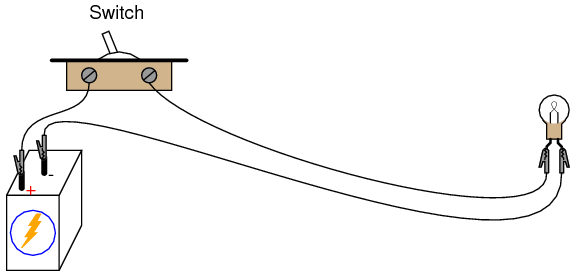2.8: Circuito con un interruptor
( \newcommand{\kernel}{\mathrm{null}\,}\)
PARTES Y MATERIALES
- Batería de 6 voltios
- Lámpara incandescente de bajo voltaje (Radio Shack catálogo # 272-1130 o equivalente)
- Longitudes de alambre largas, calibre 22 o más grandes
- Interruptor de luz doméstico (estos están fácilmente disponibles en cualquier ferretería)
Los interruptores de luz domésticos son una ganga para estudiantes de electricidad básica. Están fácilmente disponibles, son muy económicos y casi imposibles de dañar con la energía de la batería. No obtenga interruptores “dimmer”, solo la variedad simple de encendido-apagado “toggle” que se usa para los controles de luz domésticos comunes montados en la pared.
Referencias cruzadas
Lecciones En Circuitos Eléctricos, Volumen 1, Capítulo 1: “Conceptos Básicos de Electricidad”
Objetivos de aprendizaje
- Comportamiento del conmutador
- Uso de un ohmímetro para verificar la acción del interruptor
Diagrama esquemático

Ilustracion

INSTRUCCIÓN
Construya un circuito de una batería, un interruptor y una lámpara como se muestra en el diagrama esquemático y en la ilustración. Este circuito es de lo más impresionante cuando los cables son largos, ya que muestra cómo el interruptor es capaz de controlar la corriente del circuito sin importar cuán físicamente grande pueda ser el circuito.
Mida el voltaje a través de la batería, a través del interruptor (mida de un terminal de tornillo a otro con el voltímetro) y a través de la lámpara con el interruptor en ambas posiciones. Cuando se apaga el interruptor, se dice que está abierto, y la lámpara se apagará igual que si se tirara un cable suelto de un terminal. Como antes, cualquier interrupción en el circuito en cualquier ubicación hace que la lámpara se desenergice (oscurezca) inmediatamente.



